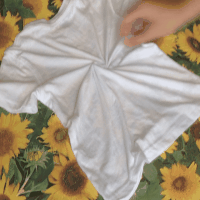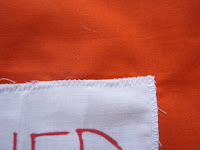I recently spent the day babysitting (or hanging out with really) a 13 year old girl, and unsurprisingly, we ended up spending the majority of our time elbow deep in fabric dye on a major tie-dying spree. I had forgotten how easy and how much fun tie-dying is. We were mainly dying baby clothes for her sister's children, but my brain is now buzzing with the endless possibilities to make super cute, colourful and inexpensive clothes and accessories. Tie-dying has recently made a come-back in high street fashion, but often is a little on the expensive side. But now I realise how easy it is, I'm planning on making the most of the trend! I thought I would do a post about the basics of tie-dying as an easy guide if this is your first time, or if you've forgotten from younger days...
What you need:
* White clothes/fabric
* Rubber gloves (the dye can be a little harsh on the skin - oh and it also stains your hands!)
* Range of cold water clothes dyes (we used these ones)
* Salt
* Buckets for the dye
* Water bottles with a squirty top
* String
* Rubber bands
1. The first thing you need to do it to prepare the clothes dye. We had a whole range of colours so that we could make lots of different designs but you can create these looks with just one colour if you want to keep things simple. Follow the instructions of the back of the pack to prepare the dye, but note that unless you are planning on dying a shed load of clothes, you won't need all the dye. We did about a quarter of each dye and still had plenty left at the end.
2. Next you need to get your fabric slightly damp. It doesn't want to be wet so it's best to squirt it with water from a bottle or spray and then squidge it a little to spread the water.
After these basic steps, you need to decide what designs you want on each item. There are a few basic techniques you can use...
FIRST DESIGN: SPIRAL

If you want to create the classic spiral design, you need to lay your fabric out on a flat surface. You then need to pinch the fabric in the middle, and twist round so that the fabric gets twisted into a spiral. It's a little hard to explain but there is a video below showing you how easy this is! You then need to tuck in all the sides so it should look something like this...
Then take some rubber bands and put them over the spiral so that it stays tightly wound as you do the dying.
There are two ways to apply the dye. The first way is the most simple and only requires one colour. For this you need the depth of the dye to be lees deep than the depth of the spiral, and then simply place the fabric in the dye and leave for approx. 30-40 mins. When you then take the fabric out and unwind it, it will have a spiral design with white and the colour of dye you are using.
The second technique is slightly more complicated but a little more fun! For this you need to put your dye into squirty top bottles. Then place the spiral of fabric on a surface (you don't mind getting dyed), and squirt the dye on, starting at the centre, and working out in circles of different colours, as seen below...
Flip the fabric over and repeat your pattern on the other side. Then leave the fabric for about 8 hours, or overnight if you can, before removing the rubber bands and unwinding to find a beautiful spiral pattern. I put mine into plastic bags overnight so that the fabric stayed clean and it didn't dry out too much.
With both techniques make sure you rinse the fabric out thoroughly until it runs clear, and then hang to dry out of direct sunlight.
SECOND DESIGN: SRIPED

To do this striped design, you need to dampen the fabric, the scrunch into a long rope. Then take strands of string and tie tightly around the fabric like this...
Then just place the fabric in the dye and leave for about 30-40 mins for the colour to soak in. If you want the stripes to be more clear cut, make sure the string is really tight and thick so that the dye can't get to the fabric underneath and stays white. When you take it out of the dye, rinse the fabric before you cut the string away, and the white bits will stay white, otherwise the dye can run into them and blur the lines.
THIRD DESIGN: DIP-DYE
One of my favourite designs, and so in fashion at the moment, the dip-dye is probably the easiest design to do. Literally just put the fabric in one colour for 20-30 mins, take out and wring, then put about a third back into a different colour and leave for another 30-40 minutes.
You can also gradually move more and more of the fabric out of the dye over the 40 mins if you want a more gradated look.
When you rinse make sure the darker colour stays below the lighter otherwise it may run.
So thats it! One of the best things about tie-dying is that you can go completely wrong and it can still turn out amazingly! So don't despair if you think you've made a mistake, you can always salvage the situation by changing tack. And there are hundreds of other designs and techniques you can use. It's just a matter of getting creative, and probably a little messy!
Enjoy :)
xoxo




























